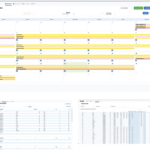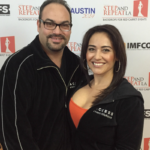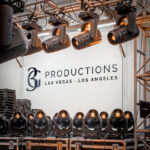 Matrix to the Max
Matrix to the Max
To get a taste of Matrix moxie, look no further than its work on the 2013 Safeway Gala. Matrix provided a seamless tent projection map over a 420-foot span. Using a Watchout media server system, the production involved warping and blending content from 22 18K-lumen projectors to create one seamless environment over the entire crowd. Aspect Lighting provided the lighting package, which consisted of 120 ETC ellipsoidals, 260 LED fixtures, 150 sticks of truss, 70 motors, 120 automated fixtures and enough cable, distro and control to support the lighting package. “All in all, three semis packed to the gills!” says Aspect owner Sid Khera. “It was great to work with Matrix on this event.”

 Likewise, for Ford South America’s 2013 summit at the Aria Resort & Casino in Las Vegas, Matrix wallpapered the space with 912 Absen LED panels for a stunning, immersive effect. At the Guess? 30th Anniversary event in mid-2012, the company outfitted the runway with ten 20K projectors and a 20-by-50 LED wall. For Disney at the Anaheim Convention Center, Matrix’s interactive LED wall allowed kids to shoot foam waffles at it.
Likewise, for Ford South America’s 2013 summit at the Aria Resort & Casino in Las Vegas, Matrix wallpapered the space with 912 Absen LED panels for a stunning, immersive effect. At the Guess? 30th Anniversary event in mid-2012, the company outfitted the runway with ten 20K projectors and a 20-by-50 LED wall. For Disney at the Anaheim Convention Center, Matrix’s interactive LED wall allowed kids to shoot foam waffles at it.
When PLSN spoke with Motal in late 2013, Matrix had just begun outfitting 150 rooms on four floors of the Venetian Hotel in Las Vegas, all HD, for 3D design software giant Autodesk’s conference. “We’re supplying everything,” he explained, “from the adaptors to the microphones to recording the sessions, with only six days to set it up. You can imagine, with all the moving parts, a fleet of trucks and an army of techs, if one little thing goes wrong — a cable’s got a bent pin, an image is missing, a line of code has an error — what can happen. The biggest challenge in producing events is being able to adapt. You’ll get on a site, the customer will say ‘I’ve got the content,’ but it won’t be formatted the way you were expecting for the way your screens are set up. You’ve got to be ready for that. Also, when you’re dealing with electronics, you have to plan and be prepared for anything and have a talented staff on hand that can adjust to anything. You don’t panic, you find a solution. It’s how you overcome and manage the surprises that makes you successful.”
Motal has certainly been successful. “My father was an entrepreneur, and I think I inherited that. In the early ‘90s, I worked selling computer memory. When I noticed customers asking for specific items related to audio-visual, I saw an opportunity.” No stranger to launching a business (he and a partner once had one called Automated Business Machines, which supplied business centers to hotels that guests could work in while on the road), he went out on his own. “With a laptop and a credit card in my apartment, I started going through the Yellow Pages and cold-calling customers. That became MVS. In 1999, I sold the business to a publicly traded company, then bought it back in 2004.”
Since then, he has seen his chosen industry pinball through many changes. “Twenty years ago,” Motal recalls, “people were using little flat LCD panels. Now you have the younger generation growing up with everything interactive and touch. Even churches. If you went to church back then, there wasn’t even projection. Now, to get younger people to come in, they’ve added flashy interactive video and music. If you went to a nightclub in Las Vegas 20 years ago, you’d probably see a band just performing. Today, it’s all electronic DJs and a ton of visual. The younger generation is used to that. They want the stimulation. If you look at the biggest concert events, like Coachella or the Electric Daisy Carnival, which draw 150,000 people over three days, it’s all brain stimulation, a lot of mapping, LED, interactive stuff. Right now, we’re working on a bid for a movie premiere involving 3-D mapping, with multiple projectors shooting on a car and making it look like it’s moving, with the tires spinning and reflections moving on the surfaces of the car. A guy with an iPad can control it and change the color of the car by touching a button. The technology has changed so fast in the past four or five years. It’s all hyper-stimulation, driven by the younger generation.”
About four years ago, Motal started working with LED tiles — 20-by-20-inch panels of LEDs that can be joined to form walls, frames, strips, curtains, columns, etc., of all sizes into which designs, video and colors can be mapped by computer. Nowadays, they are the sine qua non of large concerts, trade shows, electronica bashes and most of the Strip in Las Vegas, Times Square, downtown Hong Kong, et al.
“The first product I got was 150-pound tiles, the first-generation LED panels,” the Matrix president recounts. “When I started buying second-generation LED from China, I realized that the products were low-quality and had issues with service. So I went to China, visited a few manufacturers and found Absen. I liked their product, but the problem was — and it’s why the Chinese companies have a hard time being successful in the U.S. — that they had no customer service. I trained an engineer from the States to service Absen’s products and convinced them to bring an engineer and a sales manager on-site. I outlined for them what to do to be successful in the U.S., and they followed those steps. Of all the import stuff coming in now, we’re one of the only companies that can offer service in the U.S. We have the spare parts, the engineers and three convenient service locations (Orlando, FL; Canfield, OH; and Orange, CA). I developed the rental and staging markets by selling tiles to regional partners” who rent them out.
These relationships with regional partners are symbiotic. Explains Motal: “In the rental market, you can have a job for 100 tiles, then all of a sudden, along comes a job for 150 tiles. If you have no partners from whom to sub-rent, you basically can’t fulfill the job. You’ll have to go through another vendor. So I developed rental partners all over the U.S. I probably sold more than 6,000 tiles to them this year. With my background in rental and staging, I understand what customers need.”
At LDI 2013, Motal visited the displays of five LED manufacturers. “The challenge they’re having is that they don’t have American representation,” he says. “You go to the booth and they don’t speak English well; they don’t have facilities in the U.S. So when vendors buy the tiles from China, if they have a problem, they have zero support. So I took the biggest players in China, started representing them here, and built an infrastructure around that. We’ve been extremely successful with that.”
Motal possesses a glow-in-the-dark enthusiasm for his work, investing his zeal not only in the success of his own company but also the well-being of his customers’ firms. He’s an evangelist for customer service. “To build a brand in the U.S., good service is paramount. If you can back the product and you can provide the service to take care of the customer, it builds your brand. The word gets out. That has helped us to grow.” He mentioned two customers who had called the week before our conversation. Both had high-profile events — one involved an automotive racing event in New Orleans; the other was a hotel opening in Houston. Both needed some guidance to feel as comfortable as they could with the product. So Matrix flew engineers to their locations at no charge. “If you take care of the people, positive word of mouth will come from it. It costs us a little to send out engineers to do on-site service, but no one else does it. It really distinguishes us.”
Motal recalled another customer at the LDI show. “He came to our booth and said he had a tour going out in two months and needed 560 tiles, a huge order. He told me he chose our product because another company he dealt with had good success with it and he’d be able to rent back and forth with them as demand rose and fell. He came to us already sold on the product because of our reputation for quality and service.”
Total Motal
The Matrix president is irrepressibly proud of the benefits customers get when working with his company. “When a customer calls, we can help design the project, come up with a look, do renderings and CAD, provide content. We can do the whole project from beginning to end, or as much or as little as they need. We also provide onsite training. If they have a complicated event and don’t have the expertise they need, I’ll send them someone who does. And we do all of our service in the U.S., so they get quick turnaround.”
Many of Motal’s moves might seem counterintuitive. “A lot of rental companies don’t want to sell the product to their customers for fear of losing future rental revenue,” he says. “My philosophy is completely the opposite. If I can help them build their business, they’re going to grow and need more product, for both rental and sales. That benefits both of us.”
And while a similar company might have 100 or 200 tiles on hand, Matrix keeps a couple of thousand in inventory. “That means we can deliver very quickly, even for larger jobs,” Motal explains. The inventory includes new A3 Pro 3mm panels, touted for their high refresh rates, and the A7, an outdoor panel with a 7mm pixel pitch.
When the economy was in free-fall a few years ago, instead of circling the wagons and taking shelter, Motal invested a lot of money in new equipment, products and people. He was counting on being in a strong position when the economy recovered.
“When things are bad, the companies that survive are the ones that own equipment,” he says. “The ones who rent equipment only make a small margin of profit. When the economy tanked, it was bad for everyone, so prices dropped. Companies holding equipment rented it more cheaply just to create cash flow. I began investing in different technologies, LED, projection HD, switching HD, different types of higher-end equipment, and brought on some very good people. When the economy started shifting back, I owned a lot of equipment, which enabled me to do high-end jobs and to be competitive. Without the equipment, it’s hard to compete at the top of the market. I leveraged myself in the downturn while trying to time when the market would get better. Fortunately, I got lucky! It also helped that I’ve built a network of tried and trusted freelancers I can use to staff up when needed. Some rental staging projects can take 100 people, but you only need them for the duration of one event.”
With tiles now lighter in weight and costing 60 to 70 percent less than they did five years ago, smaller companies are able to get into the rapidly expanding market. With the total pie growing, he foresees 2014 as a great year for the whole industry. Most companies are now running at close to maximum capacity, he says. “At the LDI show, even with 13 people in our booth, we were so busy we could barely keep up. I don’t turn down previous customers, but we’re at a point now where we pass on some jobs so we don’t set ourselves up for failure by taking on too much.” The sales side, under the moniker MVS LED, is growing rapidly and finished 2013 with about $15 million in LED sales. Concludes Motal: “I enjoy the challenges of making a business work. It’s been a great ride.”
For more on Matrix Visual Solutions, please visit www.matrixvisual.com.


